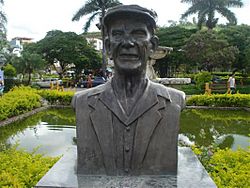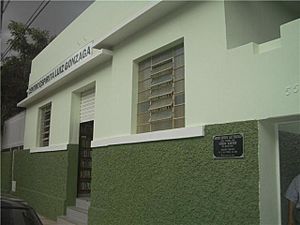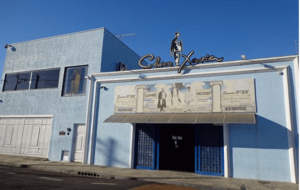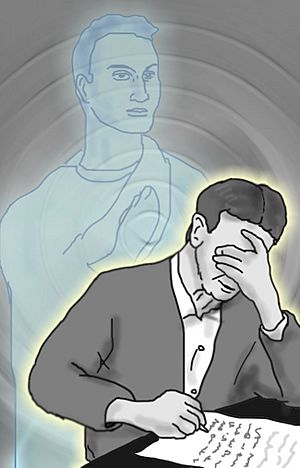Chico Xavier facts for kids
Quick facts for kids
Chico Xavier
|
|
|---|---|

Bust of Chico Xavier in his hometown, Pedro Leopoldo
|
|
| Born |
Francisco Cândido Xavier (formerly Francisco de Paula Cândido)
April 2, 1910 Pedro Leopoldo, Minas Gerais, Brazil
|
| Died | June 30, 2002 (aged 92) Uberaba, Minas Gerais, Brazil
|
| Nationality | Brazilian |
| Known for | Popular medium and philanthropist of Spiritist movement |
Chico Xavier (born Francisco de Paula Cândido, April 2, 1910 – June 30, 2002) was a very well-known Brazilian person. He was a philanthropist, meaning he helped others, and a Spiritist medium. A medium is someone who claims to communicate with spirits.
For 60 years, Chico Xavier wrote over 490 books and thousands of letters. He said he wrote them using a special process called "psychography". This means he believed spirits guided his hand to write. More books based on his old writings were published after he passed away, bringing the total to 496.
The books Chico wrote covered many topics. These included religion, philosophy, historical stories, poetry, and even science. He also wrote thousands of letters to comfort families who had lost loved ones. These letters were said to be from the spirits of the deceased.
His books sold about 50 million copies. All the money earned from these books went to help people in need. Chico Xavier was born in Pedro Leopoldo, Brazil. "Chico" is a common nickname for "Francisco" in Portuguese. He often said his main spiritual guide was named Emmanuel.
Chico Xavier appeared on TV shows in the late 1960s and early 1970s. These appearances helped make Spiritism a major belief in Brazil. Today, more than 5 million people follow Spiritism there. He continued his work until his death on June 30, 2002, in Uberaba. In 2010, a movie about his life, called Chico Xavier, was released.
In 2012, a TV show in Brazil named Chico Xavier "The Greatest Brazilian of all time." This was based on a survey where viewers voted for their favorite Brazilians.
Chico Xavier's Life Story
Early Life and Special Gifts
Chico Xavier's father, João Cândido Xavier, sold lottery tickets. His mother, Maria João de Deus, was a Catholic housewife. Biographers say Chico's special ability to communicate with spirits started when he was only four years old. He claimed he could hear and see spirits.
His mother passed away when he was five. He said he continued to talk with her spirit for some years. At first, people thought he was confused because he talked to spirits. When he was seven, his father remarried Cidália Batista. She wanted all nine children to live together.
Chico started public school around this time. His mother's spirit stopped contacting him then. He began working very young to help his family. He would sell vegetables grown at home.
At school and church, Chico's special abilities often caused problems. Once, in primary school, he said a spirit dictated his essays. No one believed him, and his teacher didn't care. One of his school essays won an award in a state contest. But in 1922, others accused him of copying, which happened throughout his life. To prove his gift, he was asked to write an essay about a grain of sand on the spot, with spirit help. He succeeded.
His stepmother, Cidália, asked Chico to ask his late mother's spirit how to stop a neighbor from stealing vegetables. The spirit advised putting the neighbor in charge of the garden. This advice worked and the stealing stopped. Chico's father was worried about his son's abilities and thought about sending him to a hospital.
A Catholic priest, Father Scarzelli, examined Chico. He decided that hospitalizing the boy was a mistake. He thought it was just "children's fantasy." The priest told the family to limit Chico's reading and make him work. Chico then got a job in a textile factory. The long hours and strict rules caused health problems for the rest of his life.
In 1924, he finished primary school and did not go back. He worked long hours as a sales clerk. Even with his strong Catholic faith and many efforts to stop, he kept having visions and talking with spirits.
Discovering Spiritism
In May 1927, Chico's sister, Maria Xavier, was having mental difficulties. Many believed this was caused by spiritual influences. This event helped Francisco use his mediumship to support his sister. It also introduced him to the Spiritist teachings.
Around the same time, he said he received a new message from his mother. She told him to do his duties and study the books of Allan Kardec. In June, Francisco started the Spiritist Center Luiz Gonzaga. It was in a wooden building owned by his brother. In July, guided by a "benevolent spirit," he began to psychograph, writing seventeen pages.
Later, Chico said that spirits of several famous poets began to communicate through him. They started to identify themselves in 1931. In 1928, he published his first psychographic messages in newspapers in Brazil and Portugal.
His First Books
He became widely known in Brazil in 1931. This was when he published Parnassus Beyond the Tomb. This book had 259 poems. Chico said these poems were written by 56 famous Brazilian and Portuguese poets who had passed away.
In 1931, Chico also met his spiritual mentor, Emmanuel. Emmanuel told him his mission was to psychograph thirty books. He said Chico needed "discipline, discipline, and discipline" to do this. Emmanuel also told him to be loyal to Jesus and Kardec's teachings. Later, Chico learned that Emmanuel had lived many lives, including as a Roman senator and a Jesuit priest.
In 1932, Parnassus Beyond the Tomb was published by the Brazilian Spiritualist Federation (FEB). This collection of poems caused a big stir in the Brazilian press. People were divided between praising it and accusing Chico of copying. The impact grew when it was revealed that a "humble clerk" from a small town wrote the books. Chico's mother's spirit reportedly advised him not to respond to the criticism.
Chico gave all the copyrights for his books to FEB. Around this time, he developed a serious eye problem called a cataract. His spiritual mentors, Emmanuel and Bezerra de Menezes, told him to get help from human doctors. They said he should not expect special healing from spirits.
He continued working as a clerk-typist at a farm. In 1935, he started helping people at the Spiritist Center Luís Gonzaga. He offered advice and produced psychographic books. The farm manager, Rômulo Joviano, was also a Spiritist. He gave Chico time off to do his psychographic work. Chico wrote one of his most famous books, Paulo e Estevão (Paul and Stephen), in Joviano's basement.
Chico always refused gifts and honors. For example, when Fred Figner left him a large sum of money in his will, Chico immediately gave it to FEB. Along with his growing fame, criticism from people trying to discredit him also grew. Chico said that even spiritual enemies tried to bother him.
A Legal Challenge
In the 1930s, Chico published books attributed to the spirit of Humberto de Campos. One of these, Brasil, Coração do Mundo, Pátria do Evangelho, told the story of Brazil in a spiritual way. This book led to a lawsuit from Humberto de Campos's widow. She wanted the copyrights for the psychographed books.
FEB supported Chico's defense. The judge decided that book copyrights apply to books written when the author is alive. The court could not prove the existence of mediumship. To avoid future problems, the spiritual author's name was changed to "Irmão X" (Brother X).
Around this time, Chico got a job as a helper in the Ministry of Agriculture. It's important to note that he never missed a day of work during his time as a public servant.
The Famous Book Nosso Lar
In 1943, one of the most popular books in Brazilian Spiritist literature was published. It was the novel Nosso Lar (Our Home). This book became a bestseller and was widely read. It was even made into a movie of the same name in 2010.
Nosso Lar was the first book in a series. The spirit of André Luiz was said to be the author. Chico Xavier's fame grew more and more. People came to him seeking healing and messages. His small town of Pedro Leopoldo became a place of pilgrimage. When his former boss, José Felizardo, died very poor, Chico worked hard to give him a proper funeral. He went around town asking for donations from everyone.
A Family Challenge
In 1958, Chico was involved in a difficult situation. His nephew, Amauri Pena, who was also a medium, told the press that he was a fraud. He also said his uncle Chico was an impostor. Chico denied doing anything wrong and said he wasn't close to his nephew. Later, Amauri felt bad for the harm he caused. He apologized and took back all his accusations. Amauri later passed away at age 27.
Testing His Abilities
In 1944, journalists David Nasser and Jean Manzon wrote a critical report about Chico. It was published in "O Cruzeiro" magazine. The reporters pretended to be foreigners using fake names to test if Chico was a fraud. Later, when Nasser and Manzon got home, they were surprised by the books Chico had given them as gifts. Nasser said in a 1980 interview: "Manzon called me and said, 'Have you seen the book that Chico Xavier gave to us?' I said no. 'Well, you see,' he said. I was in my library, I picked up the book and written there was this: 'To my brother David Nasser, Emmanuel.' He had made a similar dedication to Manzon. It is things like that make me very afraid to get involved in Spiritism issues."
Working with Waldo Vieira
Around this time, Chico Xavier met Waldo Vieira, a young medical student and medium. Together, they psychographed several books. They worked together for some years before going their separate ways. In 1959, Francisco moved to Uberaba, where he lived until he passed away.
He continued to psychograph many books. These books covered topics important in the 1960s, like youth issues, technology, and space travel. Uberaba became a place where thousands of people came every day. They hoped to connect with deceased family members. Books of "messages" became popular. These were letters from spirits of regular people to their families. Chico also organized constant campaigns to give food and clothing to the poor in the town.
On May 22, 1965, Chico Xavier and Waldo Vieira traveled to the United States. They wanted to share Spiritism there. With the help of Salim Salomão Haddad and his wife Phillis, they studied English. They also launched the book The World of The Spirits.
TV Appearances
In the early 1970s, Chico appeared on a very popular TV interview show called "Pinga Fogo" (Dripping Fire). It had extremely high viewership across Brazil. In the same year, besides his eye and lungs problems, Francisco developed a heart condition called angina. In 1975, he founded the Spiritist center "Casa da Prece" (House of Prayer) in Uberaba.
Later Years and Global Fame
By this time, his fame spread to other parts of the world. Several of his books were translated into other languages. Some were even adapted into TV soap operas. By the end of the 1990s, Chico had psychographed more than 400 books. It was estimated that about 50 million Spiritist books were circulating in Brazil. Of these, 15 million were attributed to Chico Xavier and 12 million to Kardec.
In 1994, an American newspaper, National Examiner, published an article. It said, "Ghost writers make novelist a millionaire." This article was also highlighted in Brazil by a magazine called Manchete. It claimed that Chico had made twenty million dollars as a "Secretary of Ghosts."
Manchete magazine continued by saying that Chico admitted his 380 books were by "ghost-writers," literally ghosts. It concluded that Chico simply wrote down books psychographed through more than 500 deceased writers and poets.
Chico did not respond to these attacks. However, FEB, the publisher of most of his books, sent a letter to the magazine. They explained that all copyrights and money from Chico Xavier's books were given to charity. They emphasized that the copyrights were given for free. This made the books affordable and helped spread the Spiritist teachings.
The president of FEB also presented a "vote of recognition and appreciation" for Chico Xavier. This was approved by the FEB National Council. The document thanked Chico for his hard work, his example of a life dedicated to study and kindness, and his help to others.
His Passing
Chico Xavier passed away on June 30, 2002, at 92 years old. He died from a cardiorespiratory arrest, which means his heart and breathing stopped. His friends and family said Chico had asked God to take him on a day when Brazilians were very happy. This way, no one would be sad about his death. On the day he passed, Brazil was celebrating winning the 2002 FIFA World Cup. Chico died about nine hours after Brazil won the game against Germany.
How He Is Remembered
In 1981, Chico Xavier was nominated for the Nobel Peace Prize. His name gathered 2 million signatures for the nomination. However, the Nobel Peace Prize that year went to the Office of the United Nations High Commissioner for Refugees.
In 1999, the government of Minas Gerais state created the "Commendation of Peace Chico Xavier." This award is given every year to people or groups who work for peace and social well-being.
In 2000, Chico was voted the "Mineiro" (person from Minas Gerais) of the 20th century. This was in a contest by a TV station. He received 704,030 votes, beating famous figures like Alberto Santos-Dumont and Juscelino Kubitschek.
After Chico Xavier died, the houses where he lived were turned into museums. These museums honor his life and work. The farm where he worked as a typist was also made into a memorial.
In 2006, Época magazine named him "History's greatest Brazilian."
In 2009, the Brazilian government named a part of an important highway, BR-050, "Chico Xavier."
In 2010, his 100th birthday was celebrated with many events in Brazil. These included two movies and a special postage stamp. The city of Uberaba also started building a memorial in his honor.
In 2012, on the TV show "O Maior Brasileiro de Todos os Tempos" (The greatest Brazilian of all times), Chico was voted the greatest Brazilian citizen of all time. He won against other famous Brazilians like Irmã Dulce, Ayrton Senna, Alberto Santos-Dumont, and Princess Isabel. He received 71.4% of the votes in the final round.
In 2016, the Chico Xavier Memorial was opened in Uberaba. In 2020, a life-size bronze statue of him was unveiled in Uberaba. In 2021, Chico Candido Xavier's name was added to the Livro dos Heróis e Heroínas da Pátria (Book of Heroes and Heroines of the Fatherland). This document honors important figures in Brazil's history.
The Movie About His Life
In April 2010, on what would have been Chico Xavier's 100th birthday, the film "Chico Xavier" was released. It was based on a book by journalist Marcel Souto Maior. The movie was directed by Daniel Filho. Three actors played Chico Xavier at different stages of his life.
His Special Way of Writing
Chico Xavier wrote most of his 450 books through psychography. He always said he was not the author of any of his books. He claimed he only wrote down what spirits told him. Because of this, he never accepted money from selling his books.
His books sold over 50 million copies in Portuguese. They were also translated into many languages, including English, Spanish, Japanese, French, German, and Chinese. He also wrote about ten thousand letters that were supposedly from deceased people to their families. Many people said these letters were real. Some of these letters were even used as evidence in four court cases. Chico Xavier gave all the copyrights for his books to charity organizations from his very first book.
His books are published by many Spiritist publishers. Even though he only finished primary school, he would write about six books a year. These included novels, stories, philosophy, and poems. He is one of the most widely read authors from Latin America.
His first book, Parnassus Beyond the Tomb, was published in 1932. It contained 256 poems attributed to deceased poets. These included famous Portuguese and Brazilian poets. The book caused a lot of discussion among writers at the time. Among his other books, Nosso Lar was the most widely circulated. It was first published in 1944 and sold over two million copies. This book was attributed to the spirit of André Luiz. It was the first of a collection of seventeen books, all psychographed by Chico Xavier. Some were written with another medium, Doctor Waldo Vieira.
A very notable psychography that became known worldwide was from a case in Goiânia, Brazil. A man named José Divino Nunes was accused of harming his best friend, Maurício Henriques. A judge accepted a psychographed letter as valid proof (along with other evidence). This letter was said to be from the spirit of Maurício himself, dictated to Chico Xavier. The case happened in October 1979. The supposed spirit of Maurício said that what happened was an accident.
Over the years, Chico produced thousands of psychographed letters for parents who came to him. They wanted to receive messages from their children who had passed away. A 1990 survey found that these letters often contained information that was very familiar to the families. Also, 35% of them had a signature identical to the deceased person's signature.
A study of Chico's brain activity during a mediumistic trance was reported in a popular magazine in 1973. It suggested that Chico showed some brain patterns that were unusual, even though he was never epileptic. Many years later, in 2010, another doctor reviewed this study. He found "no evidence to suggest clinical abnormality" in Chico's brain activity.
In 2013, Brazilian scientists compared recent medical knowledge with twelve of Chico Xavier's psychographed works. These works were attributed to the spirit of André Luiz. The scientists found that these books contained very complex and correct information about the pineal gland. This information was only scientifically confirmed 60 years after the books were published. The scientists noted that Chico had little formal education and was not involved in health. This raised deep questions about whether the works truly came from spiritual communication.
Some of His Books
| Year | Book | English version | Spiritual author | Editor |
|---|---|---|---|---|
| 1932 | Parnaso de Além-Túmulo | Several | FEB | |
| 1937 | Crônicas de Além-Túmulo | Humberto de Campos | FEB | |
| 1938 | Emmanuel | Emmanuel | FEB | |
| 1938 | Brasil, Coração do Mundo, Pátria do Evangelho | Humberto de Campos | FEB | |
| 1939 | A Caminho da Luz | On the Way to the Light | Emmanuel | FEB |
| 1939 | Há Dois Mil Anos | Two Thousand Years Ago | Emmanuel | FEB |
| 1940 | Cinquenta Anos Depois | Fifty Years Later | Emmanuel | FEB |
| 1941 | O Consolador | Emmanuel | FEB | |
| 1942 | Paulo e Estevão | Paul and Stephen | Emmanuel | FEB |
| 1942 | Renúncia | Renunciation | Emmanuel | FEB |
| 1944 | Nosso Lar | Nosso Lar: Life in the Spirit World | André Luiz | FEB |
| 1944 | Os Mensageiros | The Messengers | André Luiz | FEB |
| 1945 | Missionários da Luz | Missionaries of the Light | André Luiz | FEB |
| 1946 | Lázaro Redivivo | Irmão X | FEB | |
| 1946 | Obreiros da Vida Eterna | Workers of the Eternal Life | André Luiz | FEB |
| 1947 | Volta Bocage | Bocage | FEB | |
| 1948 | No Mundo Maior | In the Greater World | André Luiz | FEB |
| 1948 | Agenda Cristã | Christian Agenda | André Luiz | FEB |
| 1949 | Voltei | Irmão Jacob | FEB | |
| 1949 | Caminho, Verdade e Vida | The Pathway, The Truth and Life | Emmanuel | FEB |
| 1949 | Libertação | Liberation | André Luiz | FEB |
| 1950 | Jesus no Lar | Jesus in the Home | Neio Lúcio | FEB |
| 1950 | Pão Nosso | Our Daily Bread | Emmanuel | FEB |
| 1952 | Vinha de Luz | Emmanuel | FEB | |
| 1952 | Roteiro | Emmanuel | FEB | |
| 1953 | Ave, Cristo! | Emmanuel | FEB | |
| 1954 | Entre a Terra e o Céu | Between Heaven and Earth | André Luiz | FEB |
| 1955 | Nos Domínios da Mediunidade | In the Realms of Mediumship | André Luiz | FEB |
| 1956 | Fonte Viva | Emmanuel | FEB | |
| 1957 | Ação e Reação | Action and Reaction | André Luiz | FEB |
| 1958 | Pensamento e Vida | Emmanuel | FEB | |
| 1959 | Evolução em Dois Mundos | André Luiz | FEB | |
| 1960 | Mecanismos da Mediunidade | André Luiz | FEB | |
| 1960 | Religião dos Espíritos | Emmanuel | FEB | |
| 1961 | O Espírito da Verdade | Several | FEB | |
| 1964 | "Desobsessão" | Disobsession | André Luiz | FEB |
| 1968 | E a Vida Continua... | And Life Goes On | André Luiz | FEB |
| 1970 | Vida e Sexo | Emmanuel | FEB | |
| 1971 | Sinal Verde | André Luiz | Comunhão Espírita Cristã (CEC) |
|
| 1977 | Companheiro | Emmanuel | Instituto de Difusão Espírita (IDE) |
|
| 1985 | Retratos da Vida | Cornélio Pires | IDE/CEC | |
| 1986 | Mediunidade e Sintonia | Emmanuel | CEU | |
| 1991 | Queda e Ascensão da Casa dos Benefícios | Bezerra de Menezes | GER | |
| 1999 | Escada de Luz | Several | CEU |
See also
 In Spanish: Chico Xavier para niños
In Spanish: Chico Xavier para niños
- Eurípedes Barsanulfo
- Divaldo Pereira Franco




